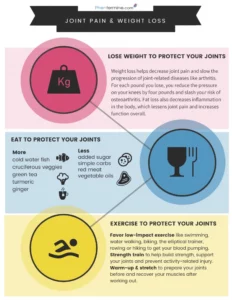Joint Pain and Weight Loss 101
Do you know anyone who’s losing weight because they’re tired of always battling achy knees or feet?
Is that person you? It’s actually a pretty common reason for people to seek healthier habits. Joint pain affects millions of Americans, and it’s even more common in overweight populations.
Thankfully studies have shown that even moderate weight loss can significantly reduce joint pain, especially in the lower body.
For those of us in constant discomfort, fewer days worried about stiff, painful joints is a big perk of losing weight with phentermine.
Here we’ll talk a little about joint pain and weight loss and then dive into some tips about joint-friendly diet and exercise.
Extra Weight, Extra Pain
Joint pain makes everyday activities like walking, bending, dressing, and driving harder, not to mention the irritation of being in constant pain.
It’s also a growing problem in the United States. The Institute of Medicine reports that over 40% of American adults suffer from chronic pain.
Knee pain is the second most common complaint, outranked only by lower back pain, among these over 100 million Americans. Chronic pain is so prevalent that some people now consider it a public health problem.
This is worrisome because both age and weight contribute to increased joint pain, and the US population is now older and heavier than ever before.
Being overweight also increases the risk of developing osteoarthritis.
Osteoarthritis, or degenerative joint disease, is a condition that develops from the breakdown of cartilage and results in swollen, painful joints.
While most people consider arthritis a natural part of later life, we can take some measures to decrease our risk. Weight loss is one of the best ways to prevent (or at least slow) the progression of osteoarthritis, particularly in the legs and feet.
Since our knees and hips bear much of the extra weight we carry, they usually see the most damage. In women, having a BMI in the overweight or obese range increases the risk of osteoarthritis by four times.
For men with similar BMIs, the risk of osteoarthritis is five times higher.
Give Your Joints a Break with Weight Loss
Luckily, even moderate weight loss can really help your joints. Losing just one pound reduces the pressure on your knees by four whole pounds!
That means a five-pound weight loss translates to twenty pounds less pressure on your knees.
For anyone that struggles with daily joint pain, the idea of taking twenty or forty pounds of daily pressure off your knees and hips sounds pretty appealing.
If you’re worried about arthritis, the benefits are even greater. One study showed that losing just eleven pounds decreases a woman’s risk of osteoarthritis by 50%.
Losing weight is also beneficial for your joints from a systemic perspective. Multiple studies have shown a link between excess fat tissue and increased inflammatory markers in the blood.
This indicates that obesity may trigger a pro-inflammatory state in the body.
Since joint pain is partially due to inflammation, lessening whole-body inflammation through general weight loss can help reduce joint pain and increase function.
No Pain, No Gain?
So far, we’ve talked a lot about how weight loss can help you lessen joint pain and damage, but unfortunately, it can also cause it.
A few common weight loss mistakes often lead to more joint pain instead of less. Using the tips and tricks below, you can throw out the “no pain, no gain” mantra.
By ensuring that our bodies are ready for the exercise we’re doing and fueled to handle the extra stress, we can avoid a lot of pain. Here are some more specific tips on how to make that happen.
Winning Strategies for Exercise with Joint Pain
One of the biggest mistakes people make with their joints is going from zero to 100 with exercise. By this, I mean going from doing little or no exercise to doing frequent, high-impact exercise like running or aerobics class.
If your muscles aren’t strong enough to support your joints in their new activities, it puts extra stress on the tendons and ligaments.
In addition to stressing the connective tissue, throwing yourself too quickly into high-impact exercise also increases your risk for injury if the muscles aren’t there to support the bones when you land weird or fall.
Therefore, it’s best to incorporate low-impact exercises while you build muscle, and then progress to higher-impact activities if you want.
Strength Training
To protect your joints from injury, strength training is a crucial part of your phentermine journey.
While working on strength, focus on correct form and mixing up your routine. Do your best to alternate days between upper body and lower body work to give your joints (and muscles) time to rest and heal.
According to the Mayo Clinic, while you may strength train three times per week when you’re just starting to build muscle, two times per week is typically enough to maintain strength once you get into a routine.
Also, remember that this need for variety applies to cardio, too, since you use (and strain) muscles and joints during cardio as well.
Cardio

With cardio, consider low-impact exercises to help ease joint pain. Even though running and group exercise classes are popular and can be very fun, they are far from the only options.
Try swimming, water walking, biking (indoor or outdoor!), the elliptical trainer, rowing, or hiking to get your blood pumping.
The pool is wonderful because even if you’re not the best swimmer, walking in the water takes most of the pressure off your joints and adds resistance to give your workout that extra boost.
Yoga, Pilates, or Tai Chi are also great options. These practices focus on balance and strength while limiting stress on your joints (especially if you speak with the teacher about movement modifications).
Before & After
Finally, take time to care for your body by warming up before and stretching after your workout.
Lots of us skip these steps because, honestly, who has the time? Still, it’s extremely important to resist the temptation to dive straight into your workout and then quit as soon as you finish.
A short 3-5 minute warm-up walk or other light movement helps get your blood flowing, warm up your joints, lessen pain and avoid potential injury. Cool down and stretching are equally important.
Your muscles sometimes contract unevenly if you abruptly stop moving after working out, which puts additional stress on the joints.
A common example of this is athletes who run hard and then stop suddenly, causing the quadriceps and hamstrings to tighten and painfully pull the knee in different directions.
Regardless of the exercise you choose, take a few minutes warm-up before and stretch at the end.
Eating for Joint Health
Diet is also important for joint health and fighting inflammation.
According to the experts at the Cleveland Clinic, certain foods can better joint health and function while others prove detrimental.
We’ll talk a little about the beneficial foods first and then move on to those you should consider limiting.
Eat More
Omega-3 fatty acids found in cold water fish (e.g., salmon or trout), flax, and chia seeds are famous for their anti-inflammatory properties.
Studies have shown that omega-3s/fish oil reduces joint pain and inflammation when consumed at least twice weekly.
Cruciferous vegetables, such as broccoli or cauliflower, are also helpful due to the sulphoraphane they contain. This antioxidant compound helps prevent joint pain and inflammation.
Tumeric and ginger are two spices that deliver both delicious flavor and inflammation-fighting properties.
Green tea is your drink of choice to help fight joint problems. Studies show that the polyphenolic compounds contained within help fight inflammation.
Eat Less
Added sugar and simple carbs – two big players in the typical American diet – may be related to increased inflammation.
This includes foods like sweets, white bread, white rice, or pasta.
Instead, opt for whole-grain variations of your favorite grains and fewer sugary foods.
These same foods that cause inflammation can also prove counterproductive to your weight loss goals in general if consumed in excess.
Red meat is another pro-inflammatory food. Even if you’re following a low-carb diet to lose weight, try to remain conscientious of your total saturated (and trans) fat intake to avoid other problems.
Omega-6 fatty acids, primarily found in vegetable oils and fried foods, are the last item on this list of foods to limit.
Even though their name sounds similar to omega-3s, the chemical composition is critically different, making omega-6s pro-inflammatory instead of anti-inflammatory.
Overall: weight loss has lots of benefits for joints, but make sure you take care to avoid causing more pain along the way.
Do you suffer from joint pain? Any tips for easing the aches and pains? Let us know in the comments section below!
Did you like the article?
Subscribe to our weekly newsletter and get our best weight loss tips straight to your inbox!









